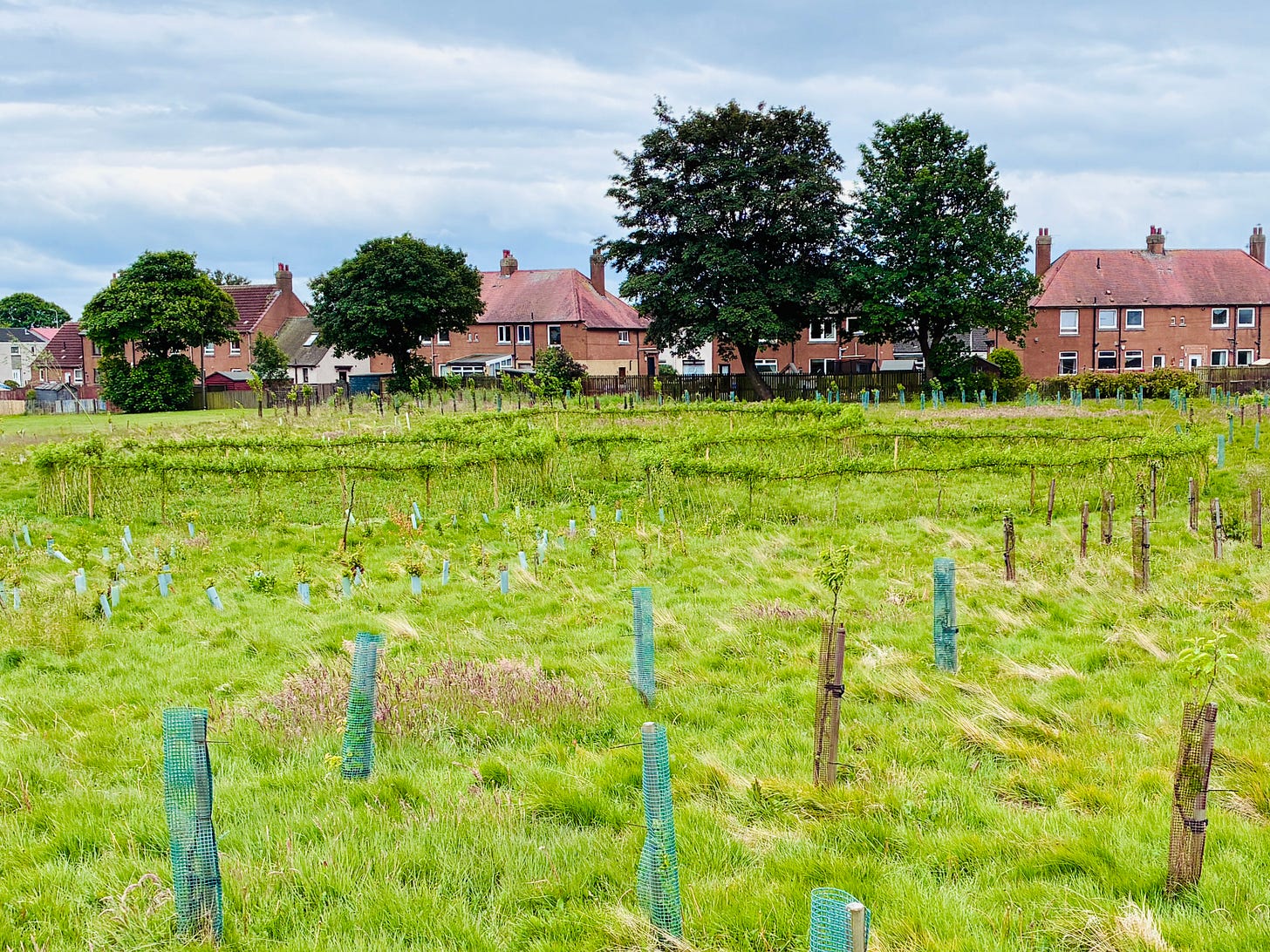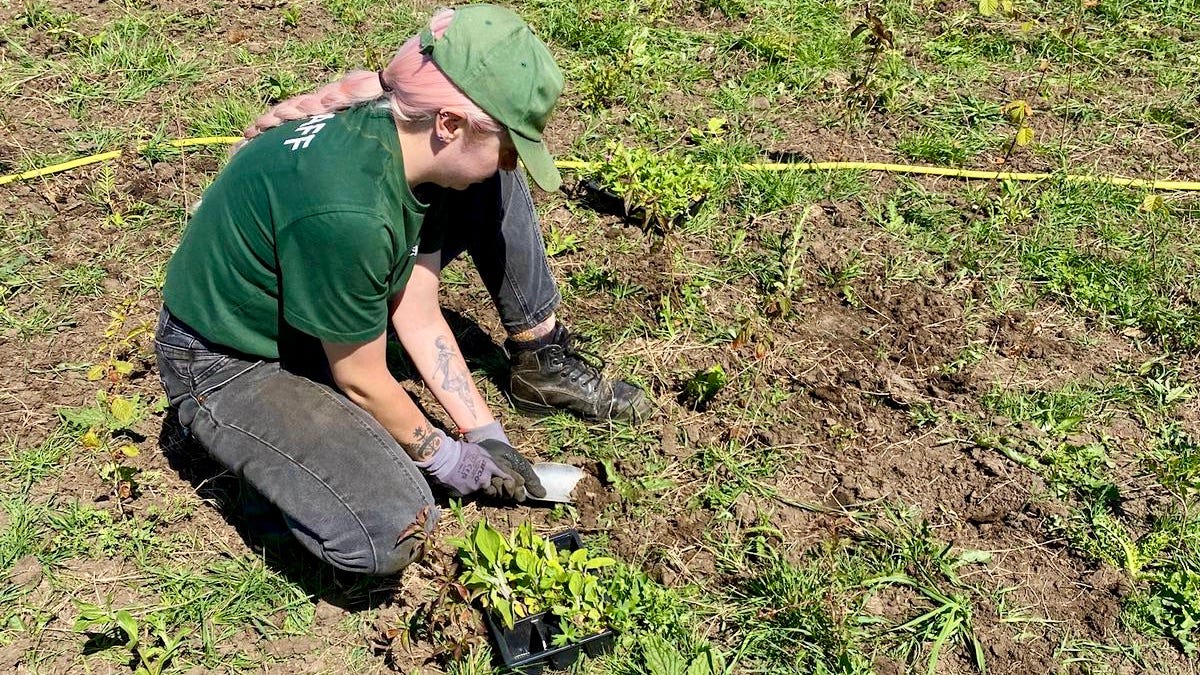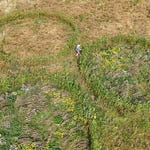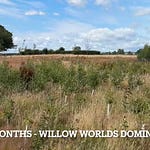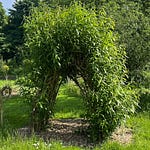I recently learned about Solarpunk and I’d like to add Solarpunk as an attribute of the Willow Worlds project. I’m saying that Willow Worlds is Solarpunk, but what is Solarpunk? Solarpunk is both a literary genre and an artistic and lifestyle movement that imagines a positive, sustainable future where people live in harmony with nature. This Substack is Solarpunk but unfortunately, it would be Solarpunk even if it was entirely imaginary. There is certainly a place for imaginary projects and writing science fiction but of course the Willow Worlds physically exists and that’s the point of a community-led research project, even if it doesn’t sound as cool. There really are Willow Worlds planted to protect other trees, to cut down on plastic tree guards and improve the ecosystem services of Muiredge Park. But now you know: there is something Solarpunk about Willow Worlds, and if you’d like to tell me about your Solarpunk project, I’d like to hear from you.
Welcome to the June episode of the Willow Worlds podcast. In this episode we’ll cover the spring drought, the tree nursery, some deer damage, our tree and now wildflower experiments and how to name 35 species of wildflowers, and why.
PART 1: April Showers Bring May Flowers
April Showers Bring May Flowers: The proverb describes the familiar rhythm of the seasons: brief, light spring rains nourishing the soil, holding moisture until May’s longer days, and stronger sun, force life into full expression. Except in 2025, the April showers never came. April passed dry, and May began with the same parched stillness. The BBC report we received just 20% of the average rainfall, it was the driest spring in 69 years. In some areas, that figure dropped to a mere 2%. I’d never seen brown grass in mid-May before.
What did this mean for the Willow Worlds project in Muiredge Park?
For one, there was a startling bloom of dandelions — all at once. Great yellow constellations lit up the place, reflecting the warm weather. Whether you see them as cheerful wildflowers offering early sustenance to bumblebees, or as stubborn garden trespassers, their abundance was remarkable. But they vanished just as quickly and before most of the bees, it seems, who missed them. This kind of disarticulation — where flowers bloom before pollinators are ready — is the ecological unravelling warned of in Silent Earth by Dave Goulson. A recommended read for everyone interested in life on Earth.
On more positive note: the willow fedge of the Willow Worlds is growing well. Digging trenches, layering manure and loosened soil in winter — helped trap enough water for the willows to manage the dry spell. The middles of the willow worlds, however, remain over-exposed to the drought. The saplings there look thirsty, the soil is too dry so we spent a little time adding some water, just to tide them over.
PART 2: Treewilding Update
Drought isn’t much of a worry in our air-pruning nursery. A solar-powered pump manages the watering here, and though it has to spend winter in the shed, it's easy to reinstall it when our now hot, dry Aprils arrives.
Now, it’s early summer, the nursery is full. Chestnut, hazel, oak, yew, willow, sycamore, and others — all jostling for light and space. The box looks crowded, but the trees are content. Leaves are upright, growth steady, no signs of stress. After two years, they’ll be pressing at the edges of this wooden world, their roots well trained. Well, hopefully well trained: we’ll see what shape they’re in later.
For now, the nursery is thriving — a small win for the trees.
PART 3: Willow Worlds vs the Wildlife
Some pupils assured me that deer don’t come near the houses. I understood why they believed that — but gently explained they were mistaken. The deer pass through at night, as silent as Slender Man. Still, I like their confidence. A strong sense of place — even when it’s not quite accurate — is a valuable thing. It means they’ve formed a vivid, high-definition picture of where they believe they live. That kind of mental mapping is part of growing up, part of how we build relationships with the world around us. When you spend time in a place — even just a few minutes each day — you start to know it deeply. You remember its shapes, its air, its sounds. And if you’ve never seen a deer there, it’s only natural to think they don’t come.
But they do.
I’ve learned not to rely on digital wildlife cameras — they don’t last long out here in klepto-land. Instead, I plant “analogue sensors”: lone willow rods, placed like decoys. Deer find them irresistible. Every spring for three years, I’ve planted unprotected willow, and every year, the deer destroy them. I might as well be planting lolipops. The results are unmistakable — bark stripped clean, trunks left smooth and pale as bone. Today the sensors worked: there was clear evidence of deer damage.
Turning to inspect the fedge — our living willow fence — I was excited to see how it had fared. To my delight, 89 out of 90 metres showed no damage. This is a mystery but it is what I had hoped. Maybe the woven pattern had confused the deer, like a shoal of fish distracting a shark. Maybe it looked artificial, like an inedible wooden trellis. Or maybe the structure carried vibrations — alarming the deer with each nudge. I might never know.
But there was one breach. I found the one place where the deer had decided to strike, on the west side of WW1. The deer had given it the old college try and a battle had ensued between little antlers and woven willow. Happily, it looks like the fedge won. The deer, having made a hole, appears to have given up. No trees inside the Willow World look damaged and we can only guess at why the deer had decided to move on without going through the hole it had made. Roe deer are lazy. I think the deer simply couldn’t be bothered to jump in for such tiny saplings. Apathy is our friend in this situation, I wonder how long we can count on this laziness.
PART 4: Tree and Wildflower Experiments
“There are no gardening mistakes, only experiments.”
Janet Kilburn Phillips.
We had hoped to compare tree growth across different soil preparations — to test whether manure, or cardboard or topsoil or some combination made a measurable difference. But the topsoil never arrived, and so, the experiment changed.
It’s tempting to think the outcome would have been obvious: of course trees will grow faster in enriched soil. But part of me wonders if the question was too simple to begin with. Anyway, now our attention has shifted — away from just the trees, and toward what grows between them.
In Willow World 1, we’ve sown yellow rattle. It’s a curious plant — semi-parasitic on grass, it quietly suppresses the height of meadows, giving other wildflowers a chance to emerge. Bees like it. And once it’s established, it tends to return year after year. Kirkcaldy has had great success with it, though I’m not sure how they managed it so effectively.

We’re also pursuing biodiversity to create resilience in our increasingly unreliable climate. In Willow Worlds 2 and 3, we used a seed mix from Scotia Seeds, a local supplier in Fife. Their “Get Nectar-rich Quick” blend offers years of colour, pollen, and surprise. It isn’t cheap — so we’re supplementing the mix with hand-collected annuals and plug plants, grown for quick impact.
There is a discussion to have about the effectiveness of using plug plants. This is what we’re investigating in WW2 and WW3: How do areas planted with seeds and plug plants compare with areas where we just sowed seeds?
We welcomed the rain in late May which must have really helped our freshly sown and planted wildflowers. We really got the timing right on that - if we’d planted the plugs in April they would all have turned to dust by now. Again, apathy was on our side this time.
Part 5: Is it unreasonable to expect me to learn 35 species of wildflowers?
Naming wildflowers never has been my cup of tea. In this post, I’m trying to change that. Some people tell me that the names of flowers is a timeless thing to know, like great books it must be nice to know such things so you can feel a greater affinity towards the world you live in. In other words, it might make me a better person. Here’s a quote I’m still working on liking, or maybe understanding fully. It’s from Robert Macfarlane’s The Lost Spells:
“As a species, we will not save what we do not love, and we rarely love what we cannot name.”
—Robert Macfarlane (2020)
Why don’t I like it? Well, not to put a finer point on it, I find this romantic notion of naming equalling loving to be a stretch. On behalf of people like me with low IQs, I’m suspicious of such talk, I believe it’s possible to love nature while failing to name wildflowers. So I don’t like it yet, but maybe I should change my mind. Robert Macfarlane is too clever to go arguing with, he’s usually more right than wrong. I intend to find a way to agree with him without attempting a brain transplant.
My starting point is that it seems unreasonable to expect me to learn the 35 species of wildflowers in the Get Nectar-rich Quick seed mix - but I need to change that. Perhaps I should reflect that these plants that have lived millions of years as part of an ecosystem rich in meaning to itself and that I should give that fact the respect it deserves. Cars, by comparison, are simply a deadly species of sofa, invented only 140 years ago, yet I can identify over 35 cars just from their logos. Wildflowers, unlike dangerous furniture, have no interest in brand awareness - they are independent of our regard. They were pre-human, they are more-than-human and they will be post-human. I should take them a bit more seriously than corporate logos because of their awesome endurance and their unique contributions to their ecosystems. The identities of wildflowers are greater than the identities of companies. Hopefully 35 species sounds a more reasonable target now, I’m still not sure about this - I’m old, I don’t learn very fast any more but I’ll give it a go.
So I’m going to start with the wildflowers in Scotia Seeds’ Get Nectar-rich Quick Mix because that’s what’s going to grow in the Willow Worlds and they are pretty common wildflowers in lowland Scotland. At 8 seconds a species, this exercise will take about 4 and a half minutes to complete. I’ll give you a photo and a few seconds to see if you can identify it and then I’ll give you the name of the wildflower. This will be a sort of field flashcard exercise to end of this episode of the Willow Worlds Podcast, and if you’ve listened this far - thank you - but you’ll have to watch the video for this next bit to make sense!
Scotia Seeds – Get Nectar-rich Quick Mix
Annuals (30%): cornflower, corn marigold, corn poppy, mayweed.
Biennials (10%): wild carrot, teasel, viper’s bugloss, weld, mullein.
Perennials (60%): yarrow, clustered bellflower, crosswort, common knapweed, lady’s bedstraw, meadow cranesbill, wood cranesbill, water avens, wood avens, common St John’s wort, rough hawkbit, ox-eye daisy, toadflax, musk mallow, black medic, wild marjoram, ribwort plantain, cowslip, selfheal, meadow buttercup, yellow rattle, red campion, white campion, hedge woundwort, upright hedge parsley, red clover.





